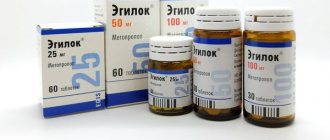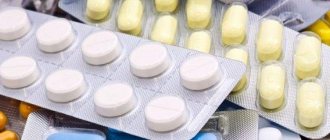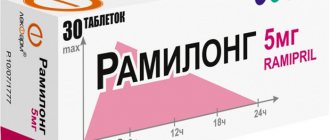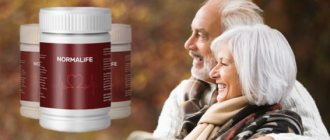Pain or fever may appear suddenly, causing a person a lot of discomfort. Combination drugs cope more successfully with different types of pain, inflammation and hyperthermia. What Askofen helps with and how many tablets you need to take to achieve the effect, we will consider further.
Pharmacodynamics and pharmacokinetics
A combined drug whose effectiveness is ensured by its constituent components.
Acetylsalicylic acid has a noticeable analgesic, antipyretic and anti-inflammatory effect, inhibits platelet aggregation .
Paracetamol also exhibits antipyretic and analgesic effects.
Caffeine increases reflex excitability of the spinal cord, stimulates respiratory and vasomotor functions, dilates blood vessels , muscles, heart, brain, kidneys, and reduces platelet aggregation . In addition, taking caffeine helps reduce drowsiness and fatigue, increase performance, and so on.
As a result of oral administration, almost 90% of the drug is absorbed. In this case, the maximum concentration of substances in the serum is achieved at different times: paracetamol - within an hour, caffeine - 2.5 hours, acetylsalicylic acid - 1-2 hours.
Almost 80% of the acidic active substances are eliminated from the body by the kidneys.
How does Askofen work?
The medication belongs to the group of non-narcotic analgesic drugs. It has anti-inflammatory, analgesic and psychostimulating effects due to the action of its constituent components:
- acetylsalicylic acid fights inflammation, relieves pain, reduces high fever, and prevents blood clotting;
- paracetamol reduces pain and relieves fever; in combination with acetylsalicylic acid, they enhance each other’s effect;
- caffeine stimulates respiratory function, increases blood pressure and heart rate.
Askofen-P during pregnancy
It should be noted that this drug is not recommended for use during pregnancy, especially in the 1st and 3rd trimester. A one-time use of the medicine in the 2nd trimester of pregnancy is allowed, but if it is clearly established that it will not cause harm to the fetus.
As is known, taking the drug in the first trimester can cause fetal malformation in the form of cleft palate caused by the teratogenic effect of acetylsalicylic acid.
In the third trimester, there remains a possibility of inhibition of labor, closure of the ductus arteriosus in the unborn baby, causing vascular hyperplasia in the lungs and hypertension in the circulatory vessels.
At what pressure is the drug taken?
For arterial hypertension, you can take tablets in small quantities for different origins or at different temperatures if there is no other pain reliever. If you have high blood levels, you can take it if the tablets are prescribed by your doctor. The drug slightly increases blood pressure, and its effect directly depends on the individual characteristics of the body. People with hypertension have mixed reactions to the drug.
For some, using it will be undefeated and the pressure will be normal, and some may feel worse after integrating it. When it comes to health, it's best to play it safe.
The caffeine content in askofene is only 0.04 mg. To significantly increase blood pressure, drink 5 tablets at a time. But in such doses you cannot take the drug, so we can say that askofen is useless for low blood pressure in most cases. The tablets contain no substances that increase blood pressure.
Instead of using medications, if well-being is not critical, it is better to walk more, sleep and eat well to increase and indicate well-being. Regular physical activity will help improve your blood pressure. For people with hypotension, more traffic is recommended so that the blood constantly circulates around the body and does not accumulate in one place. A sedentary lifestyle and staying indoors are often contraindicated to the use of antihypertensive drugs.
Ginseng or Eloterococa tincture will help fight low blood pressure. These herbal agents are taken in the morning. Tons and efficiency increase, reduce drowsiness and apathy.
Contraindications for use
- intolerance to the drug or its components;
- various gastrointestinal lesions;
- disorders of the liver or kidneys;
- abnormalities in the functioning of the respiratory system, for example, with asthma;
- dissecting aortic aneurysm;
- some disorders of the nervous and cardiovascular system;
- age less than 15 years;
- lactation, pregnancy and so on.
Side effects
When treated with this drug, various problems may arise in the gastrointestinal tract in the form of: anorexia, nausea, vomiting, gastralgia, diarrhea, erosive and ulcerative damage, bleeding. liver or kidney failure, tachycardia and increased blood pressure is also possible
Long-term use of the medication causes: dizziness, tinnitus, headache, hypocoagulation, various undesirable syndromes and liver dysfunction .
Askofen tablets, instructions for use (Method and dosage)
As the instructions for use of Askofen-P indicate, these tablets are prescribed to be taken after meals 2-3 times a day in an amount of 1-2 pieces. In this case, the maximum daily dosage should not exceed 6 pieces, and the break should be less than 4 hours.
Considering the indications for the use of Askofen, you need to observe some features of administration:
- It is better to take the tablets with milk, regular warm or mineral water;
- patients with impaired renal or liver function need to increase the interval between taking the medicine - from 6 hours.
In addition, the course of pain therapy should not exceed 5 days and treatment of fever should not exceed 3 days. In other cases, the duration of treatment and dosage is determined by the doctor.
Dosage regimen
The tablets are taken orally after meals. You can use water for drinking, but milk or alkaline mineral water is better.
Schemes depend on the type of tablets.
Askofen P according to the instructions is taken twice or thrice a day, one or two tablets, no more than six tablets per day with an interval of four hours. For renal pathologies - with an interval of six hours.
Askofen Ultra as an analgesic is taken one tablet at an interval of 4-6 hours.
For fever - two tablets at intervals of 6 hours. The maximum number of tablets per day is six.
For pain relief, it is allowed to take a maximum of five days, to reduce a high temperature - a maximum of three.
Overdose
In case of overdose, the following may occur:
- nausea, vomiting, pain in the gastrointestinal tract;
- sweating, pale skin;
- tachycardia;
- tinnitus;
- drowsiness, collapse, convulsive state;
- bronchospasm, breathing problems and so on.
If there is a suspicion of poisoning , then you need to urgently call for medical help. Usually the victim's stomach is washed and adsorbents are prescribed.
Possibility of use for hypertensive patients
Is it true that Askofen increases blood pressure and should you absolutely not take it if your blood pressure is high? The instructions do not say that the drug directly affects blood pressure levels, but it is still possible to draw a conclusion about the effect of the active components of the tablets on the body’s condition:
- acetylsalicylic acid - slightly thins the blood and promotes the expansion of capillaries, but does not have a direct effect on blood pressure levels;
- phenacetin – does not affect the functionality of blood vessels and the state of blood flow;
- paracetamol – slightly increases blood pressure, but is not indicated for combating hypotension;
- Caffeine is a substance that increases blood pressure; at low blood pressure, it helps to expand vascular tone and stabilize the hypotensive state.
It follows from this that not a single active component of the drug is capable of causing a sharp increase in blood pressure, except for caffeine, and even then, this substance can increase blood pressure by only a few mmHg.
However, for hypertension, if the doctor has prescribed these pills, the patient needs to keep blood pressure levels under control at all times. Stories that taking Askofen with high blood pressure provokes the onset of a hypertensive crisis are not confirmed by anything. Because the dose of caffeine contained in the drug is too small to produce such serious negative consequences.
Interaction
Simultaneous treatment with Askofen-P leads to increased effects of heparin , reserpine, indirect anticoagulants, steroid hormones and some hypoglycemic agents . It is also likely that the effectiveness of furosemide, spironolactone , and antihypertensive and anti-gout drugs , which help remove uric acid from the body, will decrease.
An increase in side effects of glucocorticosteroids , methotrexate sulfonylurea derivatives , as well as non-steroidal anti-inflammatory drugs and non-narcotic analgesics was noted.
It is not recommended to combine this medicine with barbiturates , antiepileptic drugs, zidovudine, rifampicin and alcohol-containing drinks, because there is a possibility of developing a hepatotoxic effect.
The effect of paracetamol increases the elimination period of chloramphenicol by almost 5 times. As for caffeine, it helps accelerate the absorption of ergotamine.
Combination therapy with Salicylamide and other stimulants of microsomal oxidation promotes the production of toxic metabolites of paracetamol , which negatively affect liver function.
Simultaneous use with Metoclopramide enhances the absorption of paracetamol . Repeated use can increase the effect of anticoagulants.
Askofen-P® (Ascophen-P)
Acetylsalicylic acid
Other non-steroidal anti-inflammatory drugs:
Increased damaging effect on the mucous membrane of the gastrointestinal tract (GIT), increased risk of developing gastrointestinal bleeding. If simultaneous use is necessary, it is recommended to use gastroprotectors for the prevention of NSAID-induced gastrointestinal ulcers, therefore simultaneous use is not recommended.
Glucocorticosteroids:
Increased damaging effect on the gastrointestinal mucosa, increased risk of gastrointestinal bleeding. If simultaneous use is necessary, it is recommended to use gastroprotectors, especially in persons over 65 years of age, therefore simultaneous use is not recommended.
Oral anticoagulants (for example, coumarin derivatives):
Acetylsalicylic acid (ASA) may potentiate the effect of anticoagulants. Clinical and laboratory monitoring of bleeding time and prothrombin time is necessary. Simultaneous use is not recommended.
Thrombolytics:
Increased risk of bleeding. The use of ASA in patients within the first 24 hours after an acute stroke is not recommended. Simultaneous use is not recommended.
Heparin:
Increased risk of bleeding. Clinical and laboratory monitoring of bleeding time is required. Simultaneous use is not recommended.
Platelet aggregation inhibitors (ticlopidine, paracetamol, clopidogrel, cilostazol):
Increased risk of bleeding. Clinical and laboratory monitoring of bleeding time is required. Simultaneous use is not recommended.
Selective serotonin reuptake inhibitors (SSRIs):
Concomitant use may affect blood clotting or platelet function, resulting in an increased risk of bleeding in general, and gastrointestinal bleeding in particular, so concomitant use is not recommended.
Phenytoin:
ASA increases the plasma concentration of phenytoin, which requires its monitoring.
Valproic acid:
ASA disrupts its binding to plasma proteins and, therefore, can lead to an increase in its toxicity. Monitoring of plasma concentrations of valproic acid is necessary.
Aldosterone antagonists (spirolactone, canrenoate):
ASA may reduce their activity due to impaired sodium excretion; proper control of blood pressure is necessary.
Loop diuretics (eg furosemide):
ASA can reduce their activity due to impaired glomerular filtration caused by inhibition of prostaglandin synthesis in the kidneys.
Concomitant use of nonsteroidal anti-inflammatory drugs (NSAIDs) may lead to acute renal failure, especially in dehydrated patients.
If diuretics are used concomitantly with ASA, ensure the patient is adequately rehydrated and monitor renal function and blood pressure, especially when diuretic treatment is initiated.
Antihypertensive drugs (ACE inhibitors, angiotensin II receptor antagonists, slow calcium channel blockers):
ASA may reduce their activity due to inhibition of prostaglandin synthesis in the kidneys. Concomitant use may lead to acute renal failure in elderly or dehydrated patients. If diuretics are used concomitantly with ASA, it is necessary to ensure adequate rehydration of the patient and monitor renal function and blood pressure. When used concomitantly with verapamil, bleeding time should be monitored.
Uricosurics (eg probenecid, sulfinpyrazone):
ASA can reduce their activity by inhibiting tubular reabsorption, leading to high plasma concentrations of ASA.
Methotrexate ≤ 15 mg/week:
ASA, like all NSAIDs, reduces the tubular secretion of methotrexate, increasing its plasma concentration and, thus, toxicity. In this regard, the simultaneous use of NSAIDs in patients receiving high doses of methotrexate is not recommended (see section "Contraindications"). In patients taking low doses of methotrexate, the risk of interaction between methotrexate and NSAIDs should also be considered, especially if renal function is impaired. If combination therapy is necessary, it is necessary to monitor a general blood count, liver and kidney function, especially in the first days of treatment.
Sulfonylureas and insulin:
ASA enhances their hypoglycemic effect, therefore, when taking a high dose of salicylates, it may be necessary to reduce the dose of hypoglycemic drugs. It is recommended to monitor blood glucose levels more often.
Alcohol
:
Increases the risk of gastrointestinal bleeding; simultaneous use should be avoided.
Paracetamol
Inducers of liver microsomal enzymes or potentially hepatotoxic substances (for example, alcohol, rifampicin, isoniazid, hypnotics and antiepileptic drugs, including phenobarbital,
phenytoin and carbamazepine
):
Increased toxicity of paracetamol, which can lead to liver damage even at non-toxic doses of paracetamol, therefore liver function should be monitored. Simultaneous use is not recommended.
Chloramphenicol
:
Paracetamol may increase the risk of increased chloramphenicol concentrations. Simultaneous use is not recommended.
Zidovudine
:
Paracetamol may increase the tendency to develop neutropenia, and therefore hematological parameters should be monitored. Simultaneous use is possible only with the permission of a doctor.
Probenecid
:
Probenecid reduces the clearance of paracetamol, which requires a reduction in the dose of paracetamol. Simultaneous use is not recommended.
Indirect anticoagulants:
Repeated use of paracetamol over a period of more than one week increases the anticoagulant effect. Occasional use of paracetamol has no significant effect.
Propantheline and other drugs that slow down gastric emptying:
Reduce the rate of absorption of paracetamol, which may delay or reduce rapid pain relief.
Metoclopramide and other drugs that accelerate gastric emptying:
Increases the rate of absorption of paracetamol and, accordingly, the effectiveness and onset of analgesic action.
Cholestyramine
:
Reduces the rate of absorption of paracetamol, therefore, if maximum analgesia is necessary, cholestyramine is taken no earlier than 1 hour after taking paracetamol.
Caffeine
Hypnotics (eg, benzodiazepines, barbiturates, H1 blockers):
Concomitant use may reduce the hypnotic effect or reduce the anticonvulsant effect of barbiturates, so concurrent use is not recommended. If simultaneous use is necessary, it is advisable to take the combination in the morning.
Lithium
:
Caffeine withdrawal may increase plasma lithium concentrations because caffeine increases the renal clearance of lithium, so lithium dosage reduction may be necessary when caffeine is withdrawn. Simultaneous use is not recommended.
Disulfiram
:
Patients being treated with disulfiram should be warned to avoid caffeine to avoid the risk of worsening alcohol withdrawal syndrome due to the stimulating effects of caffeine on the cardiovascular and central nervous systems.
Ephedrine-like substances:
Increased risk of developing drug addiction. Simultaneous use is not recommended.
Sympathomimetics or levothyroxine:
Due to mutual potentiation, they can enhance the chronotropic effect. Simultaneous use is not recommended.
Theophylline
:
Concomitant use reduces the excretion of theophylline.
Antibacterial drugs from the quinolone group, enoxacin and pipemidic acid, theobinafine. cimetidine, fluvoxamine and oral contraceptives:
Increased half-life of caffeine due to inhibition of hepatic cytochrome P450, therefore patients with impaired liver function, cardiac arrhythmias and latent epilepsy should avoid caffeine.
Nicotine, phenytoin and phenylpropanolamine:
Reduces the terminal half-life of caffeine.
Clozapine
:
Caffeine increases clozapine serum concentrations, likely through both pharmacokinetic and pharmacodynamic mechanisms. Monitoring of serum concentrations of clozapine is necessary. Simultaneous use is not recommended.
Analogs
Level 4 ATC code matches:
Acetylsalicylic acid
Aspirin-S
Citropak
Aspirin
Citramon
Coficil-Plus
Farmadol
Cefekon N
Aquacitramon
Upsarin UPSA
Citrapack
Alca Prim
Thrombopol
Citrapar
The following drugs also have a similar effect: Orafen, Flexen, Diclovit, Artrosilene, Bofen and others.
Reviews about Askofen-P
As numerous patient reviews left on various forums show, this drug is an excellent, inexpensive and effective combination remedy. Many users have been taking Askofen tablets for a long time, which does not reduce the therapeutic effect, since they use them periodically.
At the same time, some patients ask what Askofen-P helps best with and how often can it be used? To this, experts answer that the tablets have equivalent analgesic, antipyretic and anti-inflammatory effects. However, when these unwanted symptoms do not disappear quickly, you need to consult a doctor.
In addition, there are many features and contraindications to taking this medicine. For example, Askofen Darnitsa is capable of exacerbating the manifestation of asthma more than other forms, causing the development of severe allergic reactions.
Does Ascofen increase or decrease blood pressure?
This drug is often taken by people suffering from arterial hypotension , that is, low blood pressure, in order to get rid of this disease. However, they claim that such treatment was recommended to them by a doctor. Most patients are satisfied with the effect produced.
Of course, this combination of substances includes a small dosage of caffeine , which is not capable of having a stimulating effect on the central nervous system, but normalizes cerebral vascular tone and accelerates blood flow. Therefore, patients with high blood pressure should take these pills with caution, and people with low blood pressure should still not abuse such therapy.
Description and characteristics of Askofen
Askofen belongs to drugs with a combined spectrum of actions. Works as an analgesic, antipyretic and anti-inflammatory in the body.
Take your tablet when:
- Heat.
- Headache and teeth.
- Cramps during menstruation.
- Muscle pain.
The drug contains several active ingredients:
- Aspirin (has an analgesic effect).
- Caffeine (supports effectiveness and dilates blood vessels).
- Paracetamol (helps in the fight against pain and neglect).
Due to the presence of caffeine in other substances, the effect is enhanced. Askofen is considered an analogue of citramon. Only the dosage of the ingredients of this medicine has been changed.
Askofen-P price, where to buy
This medicine is available to almost all patients, since in Russian pharmacies its price starts from 14 rubles.
- Online pharmacies in RussiaRussia
- Online pharmacies in KazakhstanKazakhstan
ZdravCity
- Askofen-P painkiller tablet.
10 pcs Pharmstandard-Leksredstva OJSC 42 RUR order - Askofen-P painkiller tablet. 20 pcs. Pharmstandard-Leksredstva OJSC
70 rub. order
show more
Release form, composition
Currently, Askofen is presented in pharmacies in two forms: Askofen-P and Askofen ultra. Both drugs are available only in tablets and have the same composition. The only difference is in the dosages.
- Askofen-P contains 200 mg of paracetamol, 40 mg of caffeine and 200 mg of acetylsalicylic acid;
- Askofen Ultra contains 250 mg of paracetamol, 65 mg of caffeine and 250 mg of acetylsalicylic acid;
Excipients include potato starch, stearic acid, calcium stearate, povidone, talc, petroleum jelly and silicone emulsion. The tablets have a white or white-pink color, a flat cylinder shape, a chamfer and a score, a slight or no odor is allowed, and a marbled color.
Sold 10 or 20 pieces per pack.








